本论文收录在《The Asian Conference on Techology in the Classroom》
Osaka Japan 2013

Weixun Cao
Arixin Electronics Inc.
Liya Hua
Jiangnan Middle School
Yuping Sang
Xishan Senior Middle School
Yingping Chen
Nanhu Primary School
Zhiqiang Xu
Arixin Electronics Inc.
Yan Huang
Arixin Electronics Inc.
Xue Li
Arixin Electronics Inc.
Abstract
A highly-efficient innovative classroom, called "Bit Laboratory", that combines the application of electrical sensors and a new type of 3D art design together for fast prototyping is presented. In order to inspire the students' spirit of innovation, everything in this classroom is designed and built by small "Bit". The chairs and desks are made from transparent bricks that the students can assemble by themselves. Electronic sensor-based "BitLab Bricks" enable the students to conceive a conceptual idea to house the electronic components using eight transparent geometric shapes in different colors. The interactive learning platform is delivered through team-based "BitLab Curriculum", which consists of four components: (1) The Inventor’s Story, (2) To Be a Good Engineer, (3) To Be a Creative Artist and (4) To Be an Enthusiastic Speaker. Each team consists of three to four students of various abilities and both genders. During each project, the team members work together and resolve conflicting ideas in order to reach a consensus on their design. Team members of varying talents shine throughout the process.
"Bit Laboratory" integrates scientific history, sensor technology with quick prototyping and public speaking in a team-based interactive learning environment. The "Bit Laboratory" has sprouted all around China in schools and tech museums. The status and impact of "Bit Laboratories" in elementary and middle schools are presented.
Keywords:Classroom teaching; Engineering Education; STEM; Public Speaking; Innovation.
I. Introduction
The 21st Century is a digital age with fast growing information and technology. Traditional teaching method is facing challenges in order to meet the demands of modern education. Students need to gain the power of creativity, innovation, team work and other important skill, such as dealing with a large amount of information and the capability of self-learning and problem solving [1].
In this paper, we present a future classroom called "Bit Laboratory", which integrates scientific history, sensor technology with quick prototyping and public speaking in a team-based interactive learning environment.
II. The Classroom of BitLab
A Classroom for imagination and creative thinking
In the form of hands-on interactive teaching. BitLab adopts advanced sensor and electronic technologies, and also creative imagination and cultivating model. It closely and naturally associates science with art to enhance children’s intuitive sense to learn on their own, and their capabilities for doing-it-yourself (“DIY”). BitLab teaches observation, contemplation and problem solving by applying knowledge while experimenting with “what if?” scenarios. Figure 1 shows pictures of BitLab classrooms at different schools.
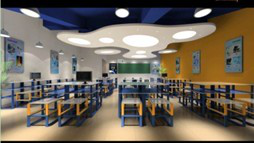
(1) Model of BitLab classroom
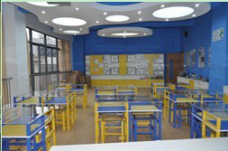
(2) BitLab at Xishan Senior Middle School
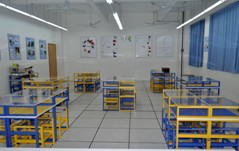
(3) BitLab at Jiangnan Middle School
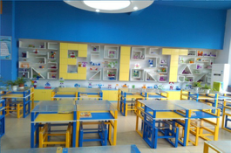
(4) BitLab at Nanhu Primary School
Figure 1: The pictures of BitLab classrooms: (1) Design model, (2) at Xishan Senior Middle School (3) at Jiangnan Middle School (4) at Nanhu Primary School
Bitlab, through its unique interactive teaching and brainstorming atmosphere, helps students to discover their own innate abilities to envision and to invent.
Self-assembled sensor-equipped chairs and desks with transparent desk surface for portable computer usage
The desks and chairs in Chinese classrooms are individual-based units. It is not suitable for team-work activities. It is difficult to repair as the entire desk or chair is one piece and cannot be dissembled. In BitLab the desks and chairs are built using same-sized building blocks. The frames of desks and chairs are made of iron or wood, as shown in Figure 2. The desktop is made of transparent acrylic material. Students can put textbooks and tablet PC under the transparent surface while performing experiments and brainstorming experiments on the desktop. Students can assemble their own tables and chairs for different teamwork requirement.
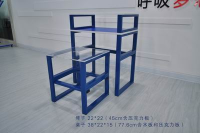
Figure 2: The desks and chairs with transparent desk surface in BitLab classrooms
Experiment kits for sensor-based electronic bricks with real-life applications
The electronic bricks contain different sensors, such as light sensor, sound sensor, ultrasonic sensor, motion detector, temperature sensor and many other actuator types. These electronic bricks can be connected together, using a common interface connection, to build real-life applications, such as a sound-activated light or a smoke detector. In BitLab, just by connecting electronic bricks together with standard wires and connectors, one can easily build a home safety monitoring system controlled by mobile phones. Such activities motivate students because school closely couples to real life. A sensor-based infrared-activated voice recorder system, just one of BitLab’s entrepreneurial educational kits is, shown in Figure 3.
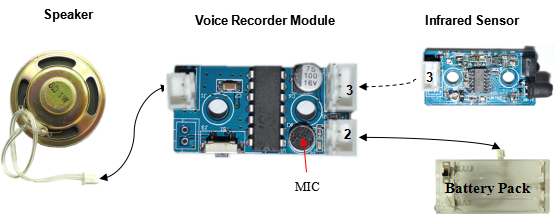
Figure 3: An infrared activated voice recorder with infrared sensor module, voice recorder module, speaker and batter pack.
By using BitLab’s electronic bricks, the time and effort needed to build real-life applications is greatly reduced. With different combinations of these electronic modules, students can quickly build electronic prototypes for real-life applications. It also enhances the students’ interest in the design of electronic systems, and stimulates students' creative thinking and hands-on practice.
Eight transparent geometric shapes of different colors to build 3-D models
To enable rapid prototyping of students’ creative designs, eight basic geometric shapes are used. Students mount the electronic bricks to the geometric shapes; some student designs resemble a house, a car or any form from the students’ imagination. These eight basic geometric shapes consist of square, rectangle, circle, triangle, quarter circle, small right angle, small rectangle and small obtuse angle, as shown in Figure 4. These bricks are made from colorful acrylic material. Uniquely designed push-pull rivets and plastic screws and nuts are used to connect acrylic plates into 3-D models. It enables students to conceive a conceptual idea to house the electronic components using eight transparent geometric shapes in different colors.
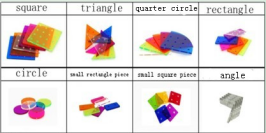
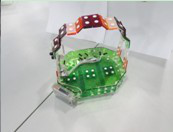
Figure 4: 3D building blocks and an infrared sensor activated fruit basket made from 3D building blocks
III. Interactive Learning Platform
The interactive learning platform is delivered through team-based "BitLab Curricula", which consists of four components: (1) The Inventor’s Story, (2) To Be a Good Engineer, (3) To Be a Creative Artist, and (4) To Be an Enthusiastic Speaker. Each team consists of three to four students of various abilities and both genders. During each project, team members work together and resolve conflicting ideas in order to reach a consensus on their design. Team members of varying talents shine throughout the process.
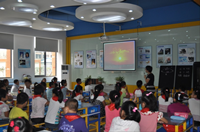
Figure 5: Learning inventors’ story
(1) The Inventor’s Story. In order to students’ spirit of curiosity and exploration, great inventor’s stories, such as Edison’s invention of the electric lamp, are told by the teachers or students during a BitLab’s class. Figure 5 shows the students at Nanhu Primary School listening to inventors’ story during BitLab’s class.
(2) To Be a Good Engineer. The second part of a BitLab class is to teach students how to effectively use the sensor-based electronic bricks to solve a real life problem. These sensor-based electronic bricks consist of different kinds of sensors, such as sound, light, temperature, ultrasonic, electromagnetic wave, infrared and many others. One such student team is shown conducting an experiment at BitLab in Figure 6.
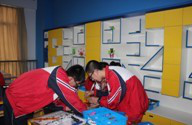
Figure 6: Experiment with sensor-based electronic bricks at BitLab
(3) To Be a Creative Artist. Having debated and conceived their product idea, then in the third part of a BitLab class, students construct the housing for electronic components using eight transparent geometric shapes, which come in different colors. The third part of a BitLab class is to let students to house the electronic components using eight transparent geometric shapes in different colors after conceiving a conceptual idea. Figure 9 shows one result of a student’s design called “CF Gemini Housing Building” at Xishan Senior Middle School.
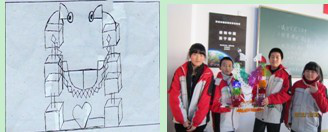
Figure 7: Artist design of a CF Gemini Housing Building
(4) To Be an Enthusiastic Speaker. After completing the prototype, each team will write up a description of their prototype and give a presentation on its features and functionalities, marketability, cost and profit expectations, and other business, environmental, and social considerations. Such teaches students confidence, practical assertiveness, and presentation skills in front of other people. Figure 8 shows the picture of one such student presentation at BitLab.
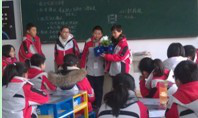
Figure 8: A student presentation about their prototype and design ideas at BitLab
IV. Conclusion
In this paper we have shown and described a new classroom, called “BitLab”, and learning philosophy designed to prepare today’s children to imagine, to set goals and teams to innovate solutions for the real-world, to compete in the market of ideas, and to do so efficiently. BitLab integrates scientific history, sensor technology with rapid prototyping and public speaking in a team-based interactive learning environment. The interactive learning platform is delivered through team-based "BitLab Curricula", which consists of four components: (1) The Inventor’s Story, (2) To Be a Good Engineer, (3) To Be a Creative Artist, and (4) To Be an Enthusiastic Speaker.
BitLab is already making a great impact on education in China. For instance, thirty (30) BitLabs have been built since 2009, to include 13 primary schools, 12 secondary schools, 3 technology museums, and 2 public youth centers. However, we still face difficulties to deploying BitLab, as most of the Chinese parents and students think that the college entrance examination is the only way to success. Further work is needed to establish a BitLab evaluation standard.
References
[1] B. Trilling and C. Fadel , 2009, 21st Century Skills: Learning for Life in Our Times, Jossey-Bass.
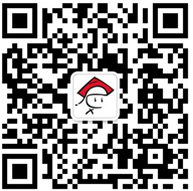
长按图片,识别二维码,一键关注
联系电话:400-034-5557
025-86651686
网址:www.mybitlab.net
地址:江苏省南京市玄武区世界之窗(板仓街9号)B4栋3楼